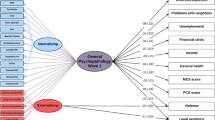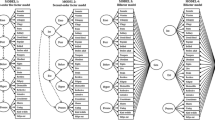Abstract
We examined 2-year recall of reports of lifetime symptomatology and substance use questions on the K-SADS-E in a sample of offspring at high and low risk for depression. Comparisons were made between those who forgot and those who remembered reports of screening symptoms made at the initial interview. In general, recall for symptoms of internalizing disorders (depression and anxiety disorder) was much worse than recall for symptoms of externalizing disorders (conduct disorder and substance use). Less than two-thirds of those initially meeting the lifetime depression screening criteria provided reports which met the lifetime screening criteria at followup. Significant correlates of screening criteria recall included the following variables (measured at the initial interview): history of treatment for any disorder, impairment on the GAS (a score less than 61), and the presence of hypersomnia and suicidal symptoms (thoughts or ideation). Logistic regression suggested that a prior report of suicidal symptoms (including thoughts, ideation, or behavior) was the most important correlate of screen recall.
Similar content being viewed by others
References
Achenbach, T. M., Connors, C. K., Quay, H. C., Verhulst, F. C., & Howell, C. T. (1989). Replication of empirically derived syndromes as a basis for taxonomy of child/adolescent psychopathology.Journal of Abnormal Child Psychology, 17, 299–323.
Achenbach, T. M., McConaughy, S. H., & Howell, C. T. (1987). Child/adolescent behavioral and emotional problems: Implication of cross-informant correlations for situational specificity.Psychological Bulletin, 101, 213–232.
American Psychiatric Association. (1980).Diagnostic and statistical manual of mental disorders (3rd ed., rev). Washington, D.C.: APA.
Bishop, Y. M., Feinberg, S. E., & Holland, P. W. (1975).Discrete multivariate analysis: Theory and practice. Cambridge, MA: MIT Press.
Bromet, E. J., Dunn, L. O., Connell, M. M., Dew, M. A., & Schulberg, H. C. (1986). Long-term reliability of diagnosing lifetime major depression in a community sample.Archives of General Psychiatry, 43, 435–440.
Chambers, W. J., Puig-Antich, J., Hirsch, M., Paez, P., Ambrosini, P. J., Tabrizi, M. A., & Davies, M. (1985). The assessment of affective disorders in children and adolescents by semistructured interview: Test-retest reliability of the Schedule for Affective Disorders and Schizophrenia for School-Age Children, Present Episode Version.Archives of General Psychiatry, 42, 696–702.
Conover, W. J. (1980).Practical nonparametric statistics. New York: John Wiley & Sons, Inc.
Edelbrook, C., Costello, A. J., Dulcan, M. K., Kalas, R., & Conover, N. C. (1985). Age differences in the reliability of the psychiatric interview of the child.Child Development, 56, 265–275.
Fendrich, M., Weissman, M. M., Warner, V., & Mufson, L. (1990). Two-year recall of lifetime diagnoses in children: The stability of child reports.Archives of General Psychiatry, 47, 1121–1127.
Fleiss, J. L. (1981).Statistical methods for rates and proportions. New York: John Wiley & Sons.
Henderson, A. S., Byrne, D. G., & Duncan-Jones, P. (1981).Neurosis and the social environment. New York: Academic Press.
Hodges, K., Cools, J., & McKnew, D. (1989). Test-retest reliability of a clinical research interview for children: The Child Assessment Schedule.Journal of Consulting and Clinical Psychology, 10, 173–189.
Jorm, A. F., Duncan-Jones, P., & Scott, R. (1989). An analysis of the retest artifact in longitudinal studies of psychiatric symptoms and personality.Psychological Medicine, 19, 487–493.
Lord, F. M., & Novick, M. R. (1968).Statistical theories of mental test scores. Reading, Massachusetts: Addison-Wesley.
Mensch, B. S., & Kandel, D. B. (1988). Underreporting of substance use in a national longitudinal youth cohort: Individual and interviewer effects.Public Opinion Quarterly, 52, 100–124.
Orvaschel, H., Puig-Antich, J., Chambers, W., Tabrizi, M. A., & Johnson, R. A. (1982). Retrospective assessment of prepubertal major depression with kiddie SADS-E.Journal of the American Academy of Child Psychiatry, 21, 392–397.
Rubio-Stipec, M., Freeman, D. H., Robins, L., Shrout, P., Canino, G., & Bravo, M. (1992). Response error and the estimation of lifetime prevalence and incidence of alcoholism: Experience in a community survey.International Journal of Methods in Psychiatric Research, 2, 501–508.
Silverman, W. K. (1991). Diagnostic reliability of anxiety disorders in children using structured interviews.Journal of Anxiety Disorders, 5, 105–124.
Silverman, W. K., & Eisen, A. R. (1992). Age differences in the reliability of parent and child reports of child anxious symptomatology using a structured interview.Journal of the American Academy of Child and Adolescent Psychiatry, 31, 117–124.
Spitzer, R. L., Endicott, J., & Robins, E. (1978). Research diagnostic criteria: Rationale and reliability.Archives of General Psychiatry, 35, 773–782.
Weissman, M. M., Wickramaratne, P. J. Warner, V., John, K., Prusoff, B. A., Merikangas, K. R., & Gammon, G. D. (1987). Assessing psychiatric disorders in children: Discrepancies between mothers' and children's reports.Archives of General Psychiatry, 44, 747–753.
Author information
Authors and Affiliations
Additional information
This research was supported in part by grants from the National Institute on Drug Abuse (grant R29DA07995), the National Institute of Mental Health (grant P50MH43878-03) and from the University of Illinois Campus Research Board. The authors would like to thank Dr. Myrna Weissman for making the data available and acknowledge the data analytic assistance provided by Yanchun Xu.
Rights and permissions
About this article
Cite this article
Fendrich, M., Warner, V. Symptom and substance use reporting consistency over two years for offspring at high and low risk for depression. J Abnorm Child Psychol 22, 425–439 (1994). https://doi.org/10.1007/BF02168083
Revised:
Issue Date:
DOI: https://doi.org/10.1007/BF02168083




